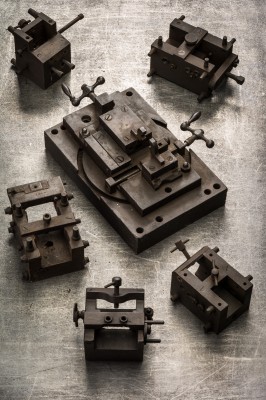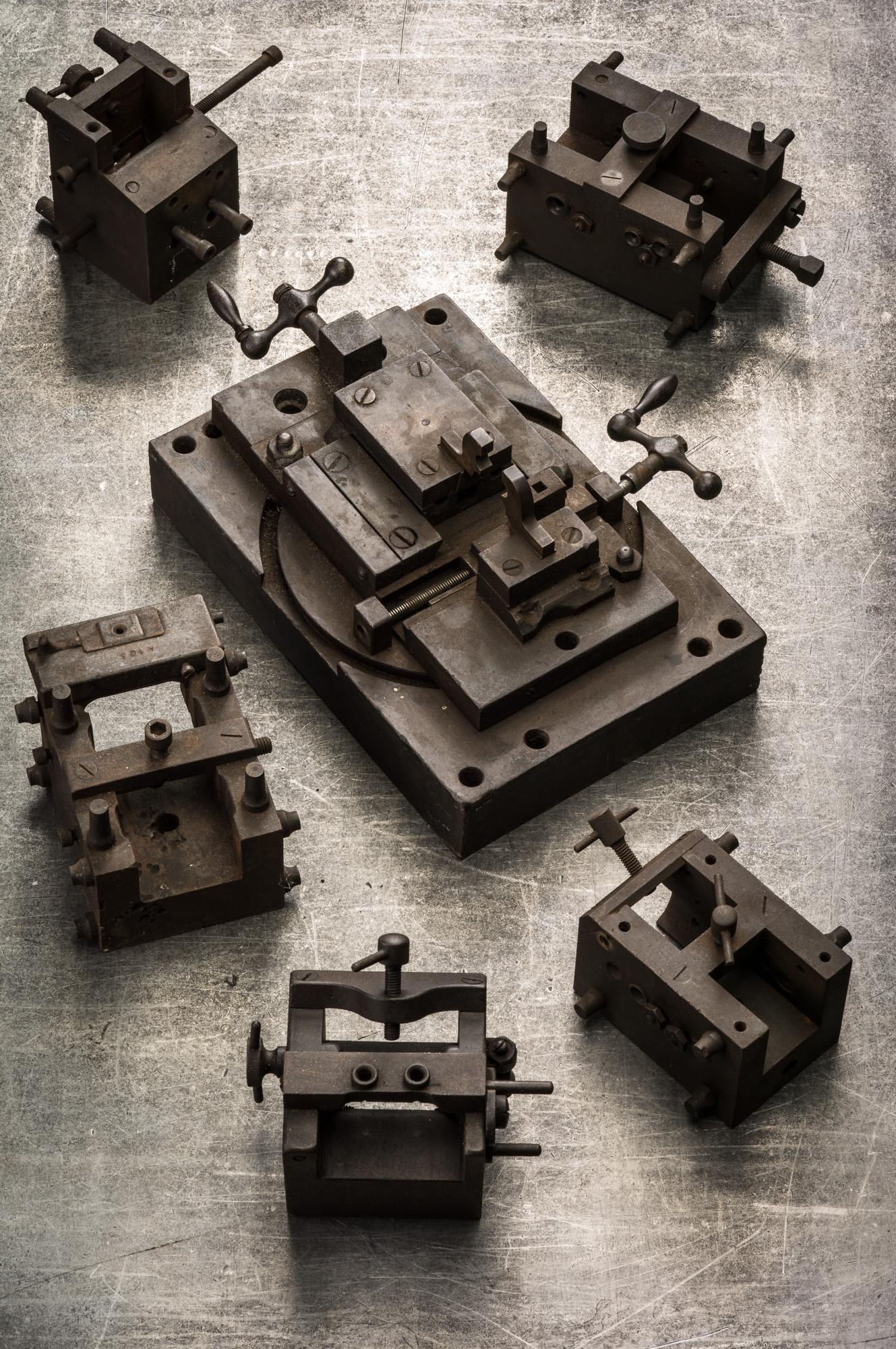Luckily, one of our gunmakers at the time, Peter Stanton, was horrified by this gesture and proceeded to salvage as many as he could from the skip, hiding them under his bench. They remained tucked away there for many years and only saw the light of day when we moved to these new premises in 2008. Here they were spread across the windowsills in the photo studio for decoration due to lack of another place to put and store them. They have been so near the camera for 7 years and now at last in front of it!
I have spoken in the past about how CNC machines that we use today, do on one machine, what we used to do on rows of machines. In the past a machine would be set up with a jig such as those in the picture and perform one operation. It could be a milling jig or a drill position jig, whatever, a batch of actions would be passed through the jig and the operation performed. The batch would then move on to the next machine and jig and another operation was performed, and so on and son on. At the end of the line a completed action.
We now use only 3 machines and the action body travels between these machines on a small datum point pallet. The milling machine does it's work and then the pallet is released and the workpiece taken to the spark erosion machine where cavities unable to be milled are made, amongst these are the solid hinge pin of the Westley Richards guns. Finally the pallet with the nearly completed action is moved to the wire machine where the final profile is cut. A total of 3 CNC machines and 2 operators versus 40 or more machines and upwards of 20 operators for the same action machining process circa 1910.




















Keith Fahl on August 21, 2015 at 8:08 pm
Simon,
Thank you for this and other historical, educational and informative entries to The Explora blog. Their content would be lost forever in time if you did not post them. A collection of these might make a great book someday if you put them all together. Please keep them coming.
Keith
Larry on August 22, 2015 at 9:16 am
This is very interesting. Obviously the craftsmen of today are the most skilled, but those of days gone by maintained a skillset that was most amazing! Thanks for sharing.
richard on August 24, 2015 at 1:03 pm
Very interesting to see pre-digital tooling..one wonders about "progress" and "modern technology" when you stop to consider that delivery time on a new gun in the pre- digital age was months rather than years or even decades that we see now. Oh for the good old days !!
Simon Clode on August 25, 2015 at 1:26 pm
I am afraid that fact is down to the numbers of workers available in the trade today as compared to the 'good old days'. We alone had 100's of workers and there were 100's if not 1000's 'in the trade'. I would say now there are less than 50 in the Birmingham area as a whole. The machining are just the start of the process of gunmaking, 'the bag of bits'. The CNC machines could, if needed, produce more than one would ever have time to put together a best guns. We use modern technology only on the parts, everything else is very old, established method!
Neill Clark on August 25, 2015 at 1:36 pm
And don't forget engraving, it adds time and money, and cannot be done by a machine. The combining of modern machining methods and skilled craftsmanship is an art in itself. Too much of the former and you have a factory produced gun, too much of the latter and you miss out on the extra degree of precision that CNC can add. I fitted DRO to my Myford lathe a few years back, it speeds up the machining and measuring of the work piece, but the quality (or lack thereof in my case) is still down to the operator.
richard on August 25, 2015 at 2:43 pm
Certainly the quality is better than ever...I have a 20g sst droplock made in 1911 (that's really "old days") that you may recall you refurbished for me at the old factory 25 years ago. It is really a superb piece of craftsmansip and I think cost about £65 new. However the identical item that you produce today is on another level. I hope you can continue to find the skilled, dedicated craftsmen from the small pool available to carry on the good work.
neil mcveigh on August 24, 2015 at 1:47 pm
Well done Peter.This is priceless.This is your heritage and almost consigned to the bin.
Live and learn!